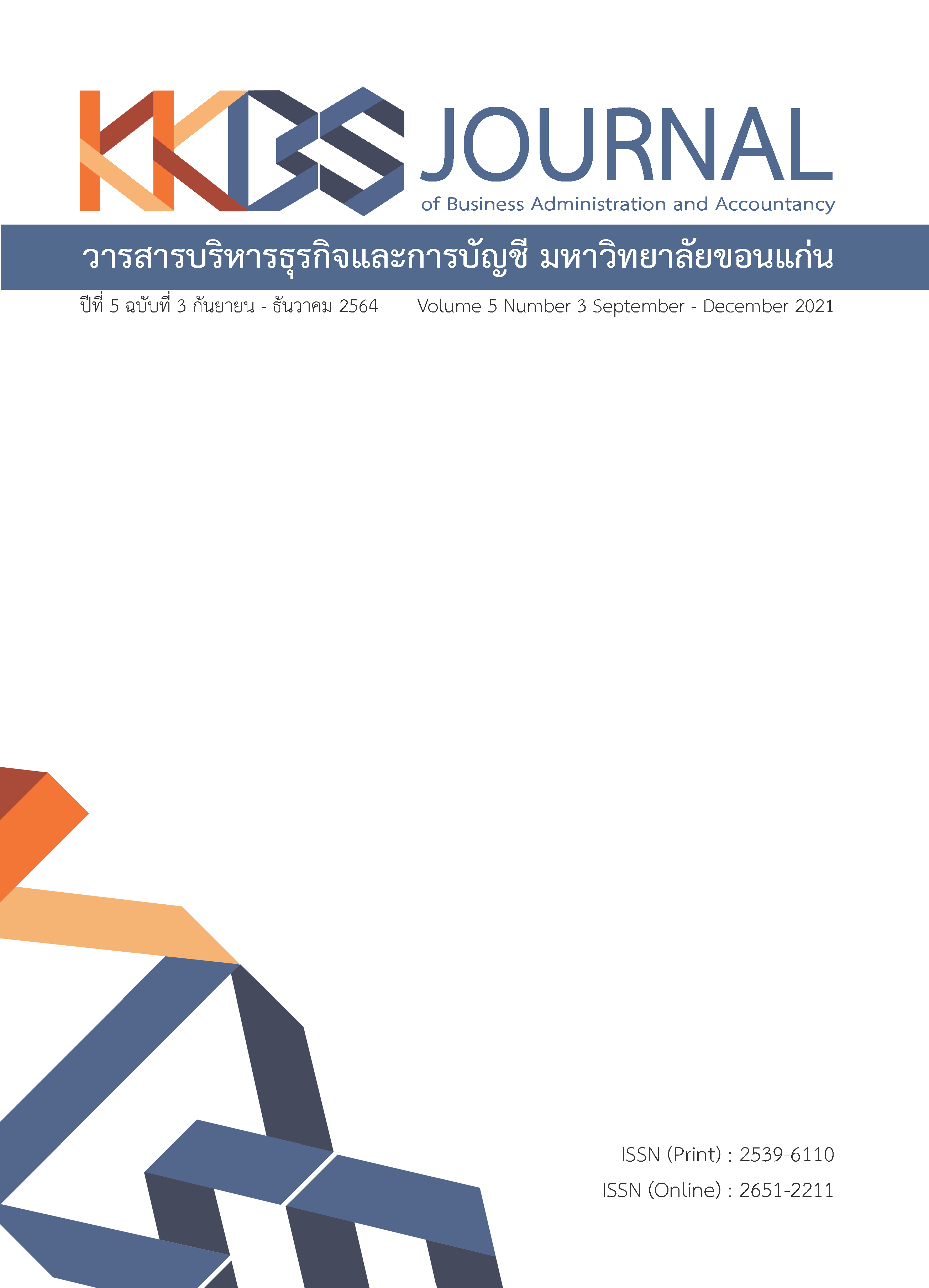การศึกษาความสัมพันธ์ระหว่างกลยุทธ์การฟื้นฟูบริการของโรงแรม การรับรู้ความเป็นธรรมของแขก และความพึงพอใจของแขกต่อการฟื้นฟูบริการ
Main Article Content
บทคัดย่อ
การศึกษาวิจัยครั้งนี้มีวัตถุประสงค์เพื่อศึกษาความสัมพันธ์ระหว่างกลยุทธ์การฟื้นฟูบริการของโรงแรม การรับรู้ความเป็นธรรมของแขก และความพึงพอใจของแขกต่อการฟื้นฟูบริการ รวมไปถึงผลกระทบการส่งผ่านของการรับรู้ความเป็นธรรมที่มีต่อความสัมพันธ์ระหว่างกลยุทธ์การฟื้นฟูบริการและความพึงพอใจในการฟื้นฟูบริการ การศึกษาครั้งนี้เป็นการวิจัยเชิงสำรวจ โดยเก็บข้อมูลผ่านแบบสอบถามแบบดั้งเดิมและแบบสอบถามออนไลน์จากกลุ่มตัวอย่างจำนวน 400 คน ซึ่งเป็นแขกโรงแรมผู้เคยมีประสบการณ์ในการได้รับความผิดพลาดจากการใช้บริการระหว่างการเข้าพักในโรงแรมในกรุงเทพมหานครและเคยมีประสบการณ์ในการได้รับการฟื้นฟูบริการ ทำการวิเคราะห์ข้อมูลด้วยค่าร้อยละ ค่าเฉลี่ย ค่าเบี่ยงเบนมาตรฐาน และทดสอบสมมติฐานด้วยการวิเคราะห์ตัวแบบสมการโครงสร้างโดยวิธีกำลังสองน้อยที่สุดบางส่วนและ Sobel’s Test
ผลการทดสอบสมมติฐานจากสมการเชิงโครงสร้าง พบว่า กลยุทธ์การฟื้นฟูบริการมีความสัมพันธ์เชิงบวกต่อความพึงพอใจในการฟื้นฟูบริการและการรับรู้ความเป็นธรรม การรับรู้ความเป็นธรรมมีความสัมพันธ์เชิงบวกต่อความพึงพอใจในการฟื้นฟูบริการ นอกจากนั้น การรับรู้ความเป็นธรรมยังทำหน้าที่ถ่ายทอดความสัมพันธ์ระหว่างกลยุทธ์การฟื้นฟูบริการไปสู่ความพึงพอใจในการฟื้นฟูบริการ เมื่อนำค่าสัมประสิทธิ์ที่ได้จากการประมาณค่ามาคำนวณหาผลกระทบทางอ้อมต่อผลกระทบโดยรวม พบว่า การรับรู้ความเป็นธรรมมีการส่งผ่านต่อความพึงพอใจในการฟื้นฟูบริการบางส่วน
Article Details

This work is licensed under a Creative Commons Attribution-NonCommercial-NoDerivatives 4.0 International License.
บทความที่ได้รับการตีพิมพ์ในวารสารเป็นความคิดเห็นของผู้เขียน มิใช่ความคิดเห็นของกองบรรณาธิการและคณะผู้จัดทำวารสาร และบทความที่ได้รับการตีพิมพ์เป็นลิขสิทธิ์ของวารสารบริหารธุรกิจและการบัญชี มหาวิทยาลัยขอนแก่น
References
Aekakul, T. (2009). Research Methods for the Behavioral and Social Sciences. Ubon Ratchathani: Ubon Ratchathani Rajabhat University. (In Thai)
Blodgett, J.G. & Tax, S.S. (1997). The effects of distributive, procedural, and interactional justice on postcomplaint behavior. Journal of Retailing, 73(2), 185-210.
Boshoff, C. (2005). A re-assessment and refinement of RECOVSAT. Managing Service Quality: An International Journal, 15(5), 410-425.
Chareonpol, V. (2011). The problem of hotel rooms overflowing Why …. and how to solve the problem. Retrieved December 24, 2019, from https: //www.scbeic.com. (In Thai)
Department of Business Development. (2018). Annual report 2018. Retrieved December 24, 2019, from https://www.dbd.go.th. (In Thai)
Ellyawati, J. et al. (2013). Perceived justice in service recovery: Study of experimental design on Indonesian customers. International Journal of Business and Management Studies, 2(2), 511–522.
Field, A. (2005). Reliability analysis. 2nd Ed. London: Sage Publications.
Goodwin, C. & Ross, I. (1990). Consumer evaluations of responses to complaints: What’s fair and why. Journal of Consumer Marketing, 7(2), 39-47.
Grönroos, C. (1988). Service quality: The six criteria of good perceived service quality. Review of Business, 9(3), 10-13.
Hair, J.F. et al. (2006). Multivariate data analysis. Upper Saddle River, NJ.: Pearson.
Hair, J.F. et al. (2014). Partial least squares structural equation modeling (PLS-SEM): An emerging tool for business research. European Business Review, 26(2), 106-121.
Ikponmwen, E. (2011). The effects of service recovery satisfaction on consumers’ behavioral intentions: An application in North Cyprus five-star hotels. Greece: Eastern Mediterranean University.
Jhantasana, C. (2020). Methods of reporting research results of second-order construct of PLS-SEM. Chulalongkorn Business Review, 42(3), 39-67. (In Thai)
Karatepe, O.M. (2006). Customer complaints and organizational responses: The effects of complainants' perceptions of justice on satisfaction and loyalty. International Journal of Hospitality Management, 25(1), 69-90.
Kelley, S.W. & Davis, M.A. (1994). Antecedents to customer expectations for service recovery. Journal of the Academy of Marketing Science, 22(1), 52–61.
Krungsri Research. (2017). Industry trends in 2018 – 2020: Hotel business. Retrieved December 20, 2019, from https: //www.krungsri.com.
Kuo, Y. & Wu, C. (2009). The relationships among service quality, perceived value, customer satisfaction, and post-purchase intention in mobile value-added services. Computers in Human Behavior, 25(4), 887-896.
Liao, H. (2007). Do it right this time: The role of employee service recovery performance in customer-perceived justice and customer loyalty after service failures. Journal of Applied Psychology, 92(2), 475-489.
Lovelock, C. (2004). Whither services marketing? In search of a new paradigm and fresh perspectives. Journal of Service Research, 7(1), 20-41.
Maxham, J.G. (2001). Service recovery’s influence on consumer satisfaction, word-of-mouth, and purchase intentions. Journal of Business Research, 54(1), 11-24.
Mostafa, R.B. et al. (2015). Corporate image: A service recovery perspective. Journal of Service Research, 18(4), 468-483.
Parasuraman, A., Zeithaml, V.A. & Berry, L.L. (1985). A conceptual model of service quality and its implications for future research. Journal of Marketing, 49(4), 41-50.
Reichheld, F.F. & Sasser, E. (1990). Zero defections: Quality comes to services. Harvard Business Review, 68, 105-111.
Smith, A.K. et al. (1999). A model of customer satisfaction with service encounters involving failure recovery. Journal of Marketing Research, 36(3), 356-372.
Tax, S.S., Brown, S.W. & Chandrashekaran, M. (1998). Customer evaluations of service complaint experiences: Implications for relationship marketing. Journal of Marketing, 62(2), 60-76.

